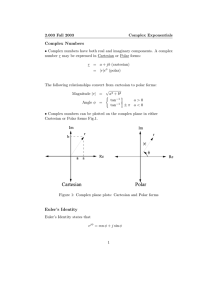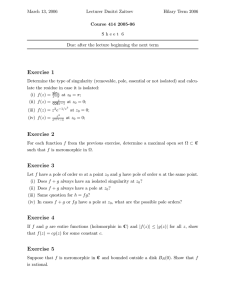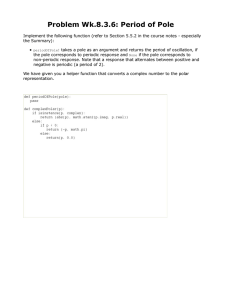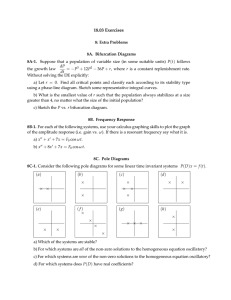Document 13664885
advertisement
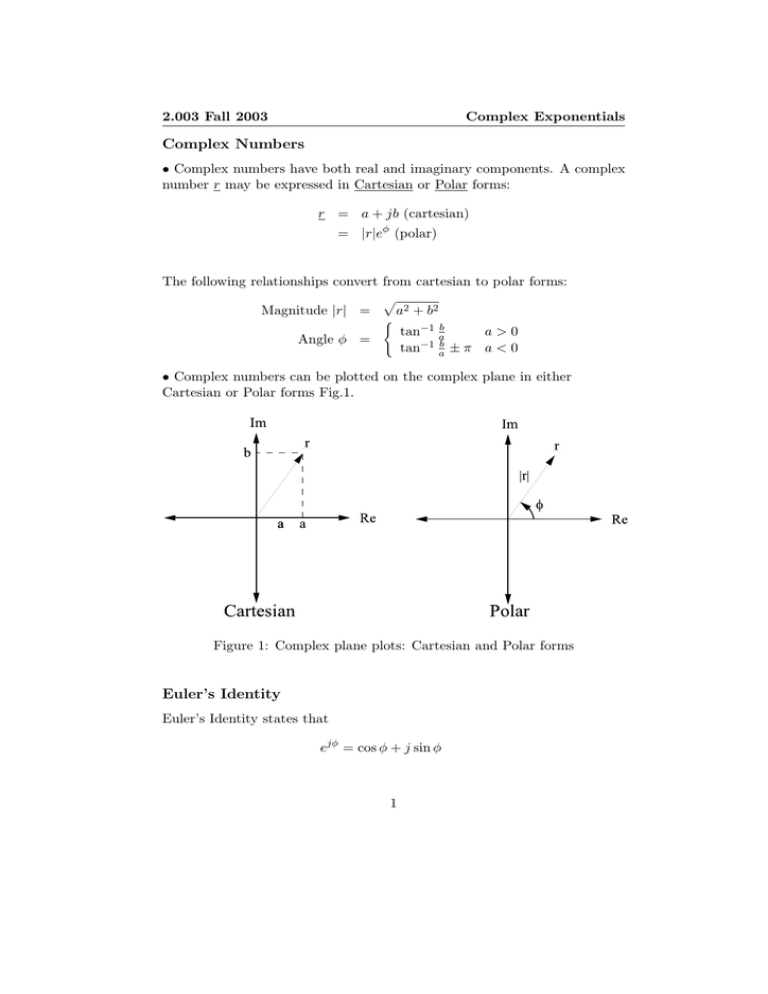
2.003 Fall 2003
Complex Exponentials
Complex Numbers
• Complex numbers have both real and imaginary components. A complex
number r may be expressed in Cartesian or Polar forms:
r = a + jb (cartesian)
= |r|eφ (polar)
The following relationships convert from cartesian to polar forms:
Magnitude |r| =
�
�
a2 + b2
Angle φ =
tan−1
tan−1
b
a
b
a
a>0
±π a<0
• Complex numbers can be plotted on the complex plane in either
Cartesian or Polar forms Fig.1.
Figure 1: Complex plane plots: Cartesian and Polar forms
Euler’s Identity
Euler’s Identity states that
ejφ = cos φ + j sin φ
1
2.003 Fall 2003
Complex Exponentials
This can be shown by taking the series expansion of sin, cos, and e.
φ3 φ5 φ7
+
+ ...
−
3!
5!
7!
φ2 φ4 φ6
cos φ = 1 −
+
+ ...
−
2!
4!
6!
φ2
φ3 φ4
φ5
−j
+
+j
+ ...
ejφ = 1 + jφ −
2!
3!
4!
5!
sin φ = φ −
Combining
cos φ + j sin φ = 1 + jφ −
φ3 φ4
φ5
(φ)2
−j
+
+j
+ ...
2!
3!
4!
5!
= ejφ
Complex Exponentials
• Consider the case where φ becomes a function of time increasing at a
constant rate ω
φ(t) = ωt.
then r(t) becomes
r(t) = ejωt
Plotting r(t) on the complex plane traces out a circle with a constant
radius = 1 (Fig. 2 ). Plotting the real and imaginary components of r(t)
vs time (Fig. 3 ), we see that the real component is Re{r(t)} = cos ωt
while the imaginary component is Im{r(t)} = sin ωt.
• Consider the variable r(t) which is defined as follows:
r(t) = est
where s is a complex number
s = σ + jω
2
2.003 Fall 2003
Complex Exponentials
t
Figure 2: Complex plane plots: r(t) = ejωt
t
t
0
Re[ r(t) ]=cos t
t
0
Im[ r(t) ]=sin t
Figure 3: Real and imaginary components of r(t) vs time
• What path does r(t) trace out in the complex plane ? Consider
r(t) = est = e(σ+jω)t = eσt · ejωt
One can look at this as a time varying magnitude (eσt ) multiplying a point
rotating on the unit circle at frequency ω via the function ejωt . Plotting
just the magnitude of ejωt vs time shows that there are three distinct
regions (Fig. 4 ):
1. σ > 0 where the magnitude grows without bounds. This condition is
unstable.
2. σ = 0 where the magnitude remains constant. This condition is
3
2.003 Fall 2003
Complex Exponentials
called marginally stable since the magnitude does not grow without
bound but does not converge to zero.
3. σ < 0 where the magnitude converges to zero. This condition is
termed stable since the system response goes to zero as t → ∞ .
e
>0; Unstable
t
=0; Marginally stable
<0; Stable
0
0
Time
Figure 4: Magnitude r(t) for various σ.
Effect of Pole Position
The stability of a system is determined by the location of the system poles.
If a pole is located in the 2nd or 3rd quadrant (which quadrant determines
the direction of rotation in the polar plot), the pole is said to be stable.
Figure 5 shows the pole position in the complex plane, the trajectory of
r(t) in the complex plane, and the real component of the time response for
a stable pole.
If the pole is located directly on the imaginary axis, the pole is said to be
marginally stable. Figure 6 shows the pole position in the complex plane,
the trajectory of r(t) in the complex plane, and the real component of the
time response for a marginally stable pole.
Lastly, if a pole is located in either the 1st or 4th quadrant, the pole is said
to be unstable. Figure 7 shows the pole position in the complex plane, the
trajectory of r(t) in the complex plane, and the real component of the time
response for an unstable pole.
4
2.003 Fall 2003
Complex Exponentials
Figure 5: Pole position, r(t), and real time response for stable pole.
Figure 6: Pole position, r(t), and real time response for marginally stable
pole.
Figure 7: Pole position, r(t), and real time response for unstable pole.
5
